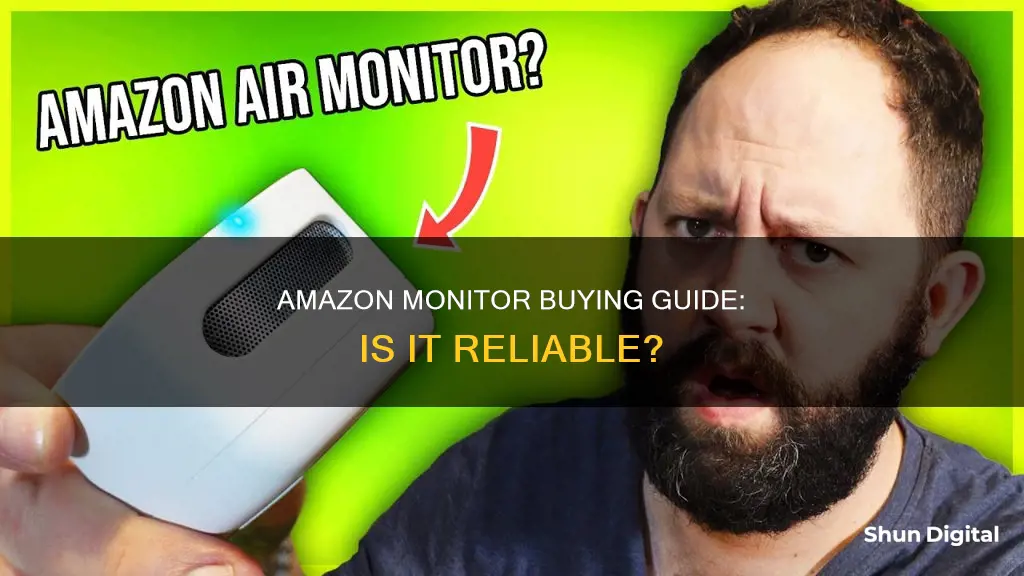
When it comes to buying a monitor, there are several factors to consider. Online shopping provides convenience, a wider selection, and often lower prices than in-store purchases. However, there are potential concerns about shipping damage and the inability to physically test the product before buying. Amazon, as a popular online retailer, offers a range of monitors from top brands and provides benefits such as free shipping and returns. Yet, it's essential to be aware of their return policies and fine print. In-store purchases, on the other hand, offer faster returns and exchanges, but may have limited stock and higher prices. Ultimately, the decision to buy a monitor on Amazon depends on individual preferences for convenience, price, and the ability to test the product before purchase.
| Characteristics | Values |
|---|---|
| Cost | Amazon is usually cheaper than in-store, but some brands have unilateral pricing policies (UPP) which means the monitor will be the same price across all authorised retailers. |
| Availability/Selection | Amazon has a nearly infinite number of models to choose from, whereas physical stores have a limited number of units and models. |
| Returns and Exchanges | Amazon has a 30-day guarantee and free return shipping on most items. Physical stores usually have a 15-30 day return policy. |
| Evaluation/Selection Process | You cannot physically check out a monitor on Amazon before purchasing, whereas in a physical store you can. However, most display units have settings like brightness at maximum, so what works in the store could be different in your home. |
| Shipping | Amazon offers free shipping on eligible orders and Amazon Prime provides expedited shipping for free on most items. |
What You'll Learn

Online vs in-store: the pros and cons of each
There are several factors to consider when deciding whether to buy a monitor online or in-store. Here are the pros and cons of each option:
Online:
Pros:
- Convenience: Shopping online allows you to compare prices and models easily without having to drive from store to store.
- Selection: Online retailers typically offer a wider range of models to choose from, and it is often easier to find specific models that may not be available in local stores.
- Price: In many cases, online prices are lower than in-store prices, even when taking shipping costs into account. This is because online retailers have lower overhead costs than physical stores.
- Returns: Reputable online retailers like Amazon often have customer-friendly return policies, with free return shipping and longer return periods than some stores.
- Delivery: You don't have to worry about transporting a large and potentially fragile item yourself, as it will be delivered to your doorstep.
Cons:
- Shipping costs: While some online retailers offer free shipping, others may charge for delivery, adding to the overall cost.
- Wait time: You will need to wait for your monitor to be delivered, which may take several days or even weeks, depending on the retailer and your location.
- Inability to inspect: You cannot physically inspect or test the monitor before purchasing it, which means you won't know if there are any issues until you receive it.
In-store:
Pros:
- Instant gratification: You can purchase the monitor and take it home with you immediately, without having to wait for delivery.
- Inspection: You can physically inspect the monitor to check for defects or issues and ensure it meets your expectations.
- Faster returns: If there is an issue with the monitor, you can usually return it to the store more quickly and easily than shipping it back to an online retailer.
- No shipping costs: You don't have to worry about paying extra for shipping or delivery.
Cons:
- Limited selection: Physical stores typically have a smaller range of models available compared to online retailers, and they may not have the specific model you want.
- Higher prices: In-store prices are often higher than online prices, as physical stores have higher overhead costs.
- Transportation: You will need to transport the monitor yourself, which can be inconvenient and risky, as there is a chance of damaging the monitor during transportation.
- Less convenience: You will need to spend time and money travelling to and from the store.
Opening a Philips LCD Monitor: Step-by-Step Guide
You may want to see also

Cost: online is usually cheaper
One of the most important factors for any shopper is the cost of the monitor. In most cases, buying a monitor online will save you money. While some brands have a Unilateral Pricing Policy (UPP), which means that a monitor should be sold at a similar price from every authorised retailer, online stores usually offer lower prices.
For example, at the time of writing, the Acer Predator XB271HU monitor is available on Amazon for a lower price than at Micro Center or BestBuy. In this case, buying online could save you over $100.
Online stores often have lower prices because they do not have the same overheads as physical retailers, such as stock upkeep and storage costs. They also offer free shipping, which can further reduce the overall cost of your purchase.
However, it is important to be a responsible buyer and check that online sellers are certified or licensed resellers. Buying from uncertified sellers may mean that you do not enjoy the full warranty benefits of the product.
Additionally, some online retailers, such as Amazon, offer price matching, where they will match the lower price you found elsewhere. This can be a great way to get the best price on your purchase.
It is also worth noting that some brands, such as Asus, may offer promo codes through their partners, which can be used to claim additional discounts or freebies.
In summary, buying a monitor online is usually the most cost-effective option, but it is important to do your research and compare prices from multiple sellers to get the best deal.
Integrating Merc Monitor and Solix: A Step-by-Step Guide
You may want to see also

Availability: online has a wider selection
When it comes to buying a monitor, availability is a key consideration. Opting to shop online offers a distinct advantage in this regard, as you'll have a much wider selection of models to choose from compared to what you'd find in physical stores.
Physical stores, especially those with limited space, tend to carry only a few select models, and there's always the possibility that the model you want is out of stock. This can be frustrating if you've already spent time researching and deciding on a particular monitor only to find that it's not available at your local store.
Online retailers, on the other hand, typically offer a vast array of options, making it more likely that you'll be able to find the exact model you're looking for. They also have the advantage of larger warehouses, so you're less likely to encounter issues with stock availability. This means you can easily find your desired cutting-edge gaming display online, and in many cases, the listed price is set below the SRP that retail stores often follow.
Additionally, with online shopping, you can easily compare prices and specifications across different models and retailers without having to drive from store to store. This makes it more convenient and efficient to find the best deal on the monitor that meets your specific needs.
So, if you're looking for a wide selection of monitors to choose from and want to avoid the hassle of limited stock, online shopping is definitely the way to go. You'll be able to find the latest models, compare prices, and have your new monitor delivered right to your doorstep.
Assembling the Acer LCD Monitor CB281HK: A Step-by-Step Guide
You may want to see also

Returns: in-store is easier, but online is still reputable
When it comes to returning a monitor, there are several factors to consider when deciding between in-store and online purchases. While returning a faulty item to a physical store may be more convenient and faster, buying from reputable online retailers like Amazon also has its advantages in terms of return policies and customer service.
In-store returns are generally quicker and more straightforward. If you encounter any issues with your monitor, you can simply bring it back to the store and request a replacement or refund. Most computer store chains have flexible return policies, typically allowing returns within 15 to 30 days of purchase. However, some stores may charge a restocking fee, so it is essential to inquire about their specific return terms beforehand.
On the other hand, returning a monitor purchased online can be more complicated, especially if you bought it from a smaller retailer. Reputable online retailers like Amazon often have customer-friendly return policies, offering free return shipping and a 30-day guarantee on most items. Nevertheless, it is crucial to read the fine print before finalizing your purchase, as some smaller retailers may have different return procedures.
While returning a monitor bought online may require more time and effort, it is worth noting that online retailers often provide excellent customer service and support. They usually have detailed return policies outlined on their websites, making it easier for customers to understand the process. Additionally, online retailers typically offer a wider selection of monitors, giving you a broader range of options to choose from.
In conclusion, while returning a monitor to a physical store may be more convenient and expeditious, buying from reputable online retailers like Amazon also has its perks. They often provide customer-centric return policies and exceptional customer service, ensuring a hassle-free shopping experience even if you need to return or exchange your purchase. Therefore, whether you choose to shop in-store or online, always remember to consider the return policy and choose a retailer with a solid reputation for customer satisfaction.
LCD Monitor: Green Line Mystery Solved
You may want to see also

Evaluation: you can't physically check an online monitor
One of the drawbacks of buying a monitor online is that you can't physically check the product before purchasing. While pictures and videos of the monitor can be helpful, they don't allow you to truly experience the display abilities of the monitor. For example, you won't be able to see the difference that a higher refresh rate or adaptive sync technology like FreeSync or G-Sync can make.
Even if you visit a physical store, most display units have their settings adjusted to maximise their appeal under the lighting conditions of the store. For instance, the brightness might be set to maximum so that the images appear more vibrant. However, these settings may not translate well to a home environment with different lighting conditions. Additionally, some companies forbid visitors from adjusting the settings on demo units, so you might not be able to see the monitor perform any differently from what you've seen online.
Therefore, it can be challenging to make an informed decision about the quality of the monitor without being able to physically test it yourself. This is a significant disadvantage of buying a monitor online, as it can be difficult to truly evaluate the display's performance and determine if it meets your needs and expectations.
Ways to Check Your Monitor's Hz
You may want to see also







